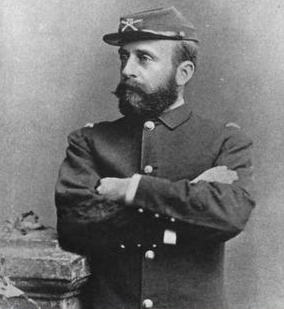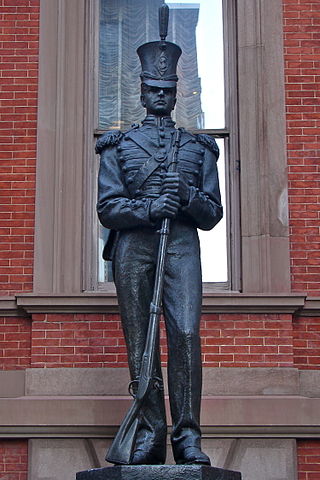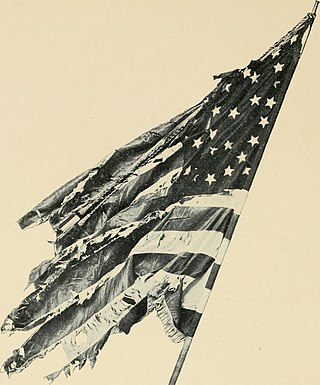Related Research Articles

Camp Curtin was a major Union Army training camp in Harrisburg, Pennsylvania, during the American Civil War. It was located north of Pennsylvania's state capitol building on 80 acres of what had previously been land used by the Dauphin County Agricultural Fairgrounds.

The Pennsylvania National Guard is one of the oldest and largest National Guards in the United States Department of Defense. It traces its roots to 1747 when Benjamin Franklin established the Associators in Philadelphia.

The 69th Pennsylvania Infantry was an infantry regiment in the Union army during the American Civil War.

The Pennsylvania Army National Guard, abbreviated PAARNG, is part of the United States Army National Guard and is based in the U.S. Commonwealth of Pennsylvania. Together with the Pennsylvania Air National Guard, it is directed by the Pennsylvania Department of Military and Veterans Affairs. The PAARNG maintains 124 armories and is present in 87 communities across the Commonwealth.

During the American Civil War, the Commonwealth of Pennsylvania played a critical role in the Union, providing a substantial supply of military personnel, equipment, and leadership to the Federal government. The state raised over 360,000 soldiers for the Federal armies. It served as a significant source of artillery guns, small arms, ammunition, armor for the new revolutionary style of ironclad types of gunboats for the rapidly expanding United States Navy, and food supplies. The Phoenixville Iron Company by itself produced well over 1,000 cannons, and the Frankford Arsenal was a major supply depot.

Sylvester Bonnaffon Jr. was a United States soldier who fought with the Union Army during the American Civil War as a first lieutenant with Company G of the 99th Pennsylvania Infantry. He received his nation's highest award for valor, the U.S. Medal of Honor, for his gallantry and leadership against Confederate troops during the Battle of Boydton Plank Road, Virginia on October 27, 1864. That award was conferred on September 29, 1893.

Jacob Gellert Frick Sr. was a United States infantry officer who fought with several Union Army regiments during the American Civil War, including as lieutenant colonel of the 96th Pennsylvania Infantry and as colonel of the 129th Pennsylvania Infantry. He received his nation's highest award for valor, the U.S. Medal of Honor, for his gallantry during the battles of Fredericksburg and Chancellorsville, Virginia. Grabbing the American flag from his regiment's color-bearer at Fredericksburg on December 13, 1862, he inspired his men to move forward "through a terrible fire of cannon and musketry"; at Chancellorsville, he personally engaged in hand-to-hand combat on May 3, 1863, to retrieve his regiment's flag which had been captured by the enemy. He was 67 years old when his Medal of Honor was conferred on June 7, 1892.

The 4th Massachusetts Volunteer Heavy Artillery Regiment was a unit that served in the Union Army during the latter part of the American Civil War. It was formed from former Unattached Companies of Heavy Artillery raised by Massachusetts to serve the state and for the defenses of Washington, D.C.
The 258th Field Artillery Regiment or "Washington Greys" is a field artillery unit of the New York Army National Guard that traces its lineage from 1789 to present. Circa 1957–1966 it consisted of four battalions.

The 91st Pennsylvania Volunteer Infantry was a Union infantry regiment which fought in multiple key engagements of the American Civil War, including the Battle of Fredericksburg, Battle of Chancellorsville and Battle of Gettysburg. It was established through the combined efforts of Edgar M. Gregory, who had received approval from the U.S. War Department to begin recruiting soldiers for an entirely new regiment during the fall of 1861, and Edward E. Wallace, who had initiated his own recruitment efforts that October. Their recruits were volunteers, the majority of whom initially enlisted for three-year terms of service from their hometown of Philadelphia; they were divided into 10 lettered companies upon muster in during early December 1861: A, B, C, D, E, F, G, H, I, and K.
Twenty-four current units of the Army National Guard perpetuate the lineages of militia units mustered into federal service during the War of 1812. Militia units from nine states that were part of the Union by the end of the War of 1812, plus the District of Columbia, are the predecessors of eighteen units that currently exist in the Army National Guard. Two of the four units derived from Virginia militias are in the West Virginia National Guard; at the time of the War of 1812, West Virginia was still part of Virginia. Only two current units, the 155th Infantry, a component of the Mississippi National Guard derived from militia units organized in the Mississippi Territory and the 130th Infantry, a component of the Illinois National Guard derived from militia units formed in the Illinois Territory, are from states or territories west of the Appalachians. Unfortunately, no militia units from the states of Kentucky, Louisiana, Ohio or Tennessee, or from the Indiana, Michigan, Missouri or Louisiana Territories, where militia units played a major role in the fighting, have survived as units in the modern Army National Guard.

The Washington Grays of Philadelphia, also known as Volunteer Corps of Light Infantry, Light Artillery Corps, Washington Grays, Artillery Corps, Washington Grays, was a volunteer regiment of the United States. Formed in 1822 in Philadelphia, the regiment became part of the Pennsylvania National Guard in 1879.
The 103rd Engineer Battalion is an engineer battalion of the United States Army, raised from the Pennsylvania Army National Guard. It is one of several current units with extensive Colonial era roots and campaign credit for the War of 1812.

The 124th Pennsylvania Volunteer Infantry was an infantry regiment that served in the Union Army during the American Civil War.
George Warren Alexander (1829-1903) was a New Hampshire native who made significant contributions to the communities of Reading and West Reading in Berks County, Pennsylvania, from the mid-1800s to the early 1900s.

The Reading Artillerists was a militia compnay formed in Reading, Pennsylvania during the late 18th century. Mustering in for the first time during the presidential era of George Washington, members of this artillery unit went on to serve tours of duty in the War of 1812, Mexican–American War and, as members of the Union Army during the American Civil War, before later disbanding.

The 12th Regiment Pennsylvania Volunteer Infantry was an infantry regiment of the Union Army in the American Civil War. Raised in Pittsburgh and its surrounding counties in April 1861 for three months of service, the regiment spent its first month in training, then guarded the Northern Central Railway in Maryland until it was mustered out. Many of its men went on to serve in subsequent Pennsylvania regiments during the war.

The 157th Pennsylvania Volunteer Infantry was a Union infantry regiment which fought in multiple key engagements during the final years of the American Civil War, including the Battle of Cold Harbor, Siege of Petersburg, and Appomattox Campaign. One of two military units raised at roughly the same time in the Philadelphia area during the fall of 1862, the 157th Pennsylvania was stationed initially at Fort Delaware, beginning in December 1862, and remained there on garrison duty until it was reassigned to the defense of Washington, D.C. during the early winter of 1863. It was then assigned to the Army of the Potomac during the spring of 1864, and sent to the front lines of the war's Eastern Theater, where it remained for the duration of the war. During a reorganization of Union Army units in the spring of 1865, its men were merged with those of the 191st Pennsylvania Infantry.
The 25th Pennsylvania Volunteer Infantry was a Three Months' Service infantry regiment which served with the Union Army during the American Civil War. Composed of Pennsylvania First Defenders, the first five companies of men who responded to President Lincoln's call for 75,000 volunteers to defend the national capital in Washington, D.C. following the Fall of Fort Sumter to Confederate States Army troops in mid-April 1861, and five additional companies of early responders who enlisted later in April 1861.
References
- 1 2 3 Fredriksen, John C. (April 1987). "The Pennsylvania Volunteers in the War of 1812: An Anonymous Journal of Service for the Year 1814" (PDF). The Western Pennsylvania Historical Magazine. 70 (2): 123.
- ↑ Dorland, W. A. Newman; Singer, Abraham; McKean, Thomas; Bradford, Thomas; Barker, John; Stein, Philip (1925). "The Second Troop Philadelphia City Cavalry (continued)". The Pennsylvania Magazine of History and Biography. 49 (1): 75–94. ISSN 0031-4587.
- 1 2 3 Bowen, Daniel (1839). A history of Philadelphia, with a notice of villages in the vicinity ... with an historical account of the military operations of the late war, including the names of over two thousand patriotic officers, and citizen soldiers ... in 1812, -13, & 14. New York Public Library. Philadelphia : Daniel Bowen.
- ↑ Foering, John Oppell (1912). Register of the Members of the Artillery Corps, Washington Grays, of the city of Philadelphia who Served in the War of the Rebellion 1861-1865. Members of the Artillery Corps, Washington Grays.